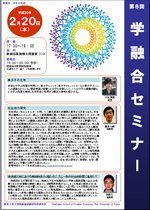AY2007 8th Gakuyugo Seminar
- Date&Time:
- Feb 20, 2008 17:30 - 19:00
- Venue:
- Large Lecture Room (2C0), New Frontier Science Bldg.

Chemistry of Single Molecules
Professor Maki Kawai
Single-molecule devices, such as single-molecule switches and single-molecule transistors, have been proposed based on the properties of various In this lecture, we will introduce recent researches on the detection of molecular properties such as vibrational states of single molecules In this lecture, we will introduce recent researches on the detection of molecular properties such as vibrational states of single molecules adsorbed on solid surfaces and their application to chemical reactions.

Research on photosynthesis
Associate Professor Kinitake Sonoike
Photosynthesis is a reaction that uses the energy of light to fix carbon dioxide into organic matter. Photosynthesis is not only an energy source for plants that supports almost all living organisms on the earth through the food chain, but also has an extremely large impact on the earth itself through the release of oxygen into the atmosphere by oxygen-evolving photosynthetic organisms that are thought to have appeared about 3 billion years ago. In addition, fossil fuels support modern civilization. In addition, fossil fuels and iron ore, which support modern civilization, were both produced as a result of photosynthesis in the past, and photosynthesis has an extremely significant meaning for the human environment. The basic framework of photosynthesis, in which light, water, and carbon dioxide produce organic matter and oxygen, was clarified at the end of the 1700s. Over the next two centuries, research clarified the structure of the reaction center that converts light energy into chemical energy and the details of the metabolic system that fixes carbon dioxide. The future of photosynthesis research will be dominated by four-dimensional analysis that adds a time factor to three-dimensional spatial information, such as environmental response, stress inhibition, and metabolic turnover in the physiological domain. In addition to this, there are three other areas of research: 1) the physical chemistry area, which deals with fast time scales such as nanoseconds and picoseconds and spatial scales at the atomic level, and where quantum mechanics is of great importance; 2) the environmental area, which deals with time scales of centuries and spatial scales on a global scale; and 3) the information biology area, which uses genome information that has developed in recent years. In this seminar, I would like to introduce the three main areas of photosynthesis research. In this seminar, I will review the history of photosynthesis research and my own past research, and introduce how research on photosynthesis intersects with physics, chemistry, and environmental studies. Reference WEB site: "Forest of Photosynthesis" http://www.photosynthesis.jp/

Distribution Mechanism of Relief Goods in Tsunami Affected Areas - Focusing on the Social Nature of Goods
Associate Professor Jin Sato
In a disaster situation that comes suddenly, there is no time to gather in-depth social information about the local culture and ethnicity that could be collected in peacetime aid activities. Therefore, instead of focusing on the social information specific to each region, we decided to focus on the social characteristics of goods that are widely used as a means of aid. Therefore, instead of focusing on the social information specific to each region, we decided to focus on the social characteristics of goods that are widely used as a means of aid. this is because we thought that we could find clues to aid that would work effectively This is because we thought that we could find clues to aid that would work effectively for vulnerable people under the tight time constraints of emergency relief. In this report, I will consider the distribution mechanism of goods using the In this report, I will consider the distribution mechanism of goods using the aid activities conducted in Thailand in response to the tsunami caused by the Sumatra earthquake that occurred on December 26, 2004.
*The contents of this page were developed based on a machine translation.

